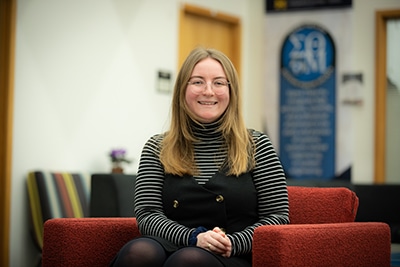- What is your degree?
- Environment and Sustainably from SEAS (School for Environment and Sustainability) focusing on Sustainable Systems with a dual degree in Energy Systems Engineering (ESE) from ISD (Integrative Systems + Design)
- Where are you from?
- Okemos, Michigan, a suburb near Lansing
- Undergrad degree?
- Statistics, with a minor in Energy Science and Policy from UM
- Can you explain what the Dow Sustainability Fellows Program is?
- There are different types of fellowships, the Dow Sustainability Fellows Program works with interdisciplinary groups of students from different colleges and backgrounds, on sustainability issues with an outside stakeholder. Such as NGOs, University of Michigan (U-M), a local city, or even another college. The Dow Fellows Program is 1 calendar year January – December. Students apply in September and usually hear in November if they are accepted. It is a very competitive program and only has 34 current fellows. If accepted to the fellowship, students receive up to $20,000 for tuition. Each project team then receives $5,000 for the project they are working on. It is expected that the teams create a solution that is of high quality and could be implemented.
- What made you apply for it?
- I was a part of Graham Sustainability Scholar’s Program which is a sister program to the Dow Sustainability Fellows, for undergraduate students. This program allowed me to meet with Dow fellows and network with them, to learn more about the program. I knew that I wanted to be a part of this graduate fellowship if I applied to U-M for my Masters.
- What project are you working on?
- I am currently working on a project team of 4 students (3 from SEAS, 2 dual degrees with SEAS and the College of Engineering, and 1 MBA student). We are working with the City of Chelsea, Michigan, on a feasibility study on community solar options. We are researching the regulations, cost, and solar options such as ground mounted, solar carports, roof top solar, and where best to place these options. The City Chelsea is unique because it owns its own energy, it’s not a part of DTE or Consumers Energy. Chelsea’s municipal utility allows them the freedom to decide what energy they want to use. This implementation of solar power is much more viable here, in Chelsea than in other areas of Michigan because their municipal energy was established so long ago (1898). Chelsea is of course interested in what the team can find out to have the most sustainable energy impact for the lowest cost.
- How have you felt that ISD has helped you?
- As a new ESE student, the degree hasn’t been that helpful yet, but the classes over the next year will help me, especially since the fellowship goes through December, 2020. The Dow Fellows Program has a lot of SEAS students because of the sustainability focus, but they like to see students from other disciplines as well so having an ESE background set me a part from other applicants and made me a more attractive candidate for the program.
- What made you interested in this degree?
- Minoring in Energy Science and Policy from U-M College of Literature, and the Arts (LSA), Program in the Environment (PitE), I was able to study energy access issues and the how to reduce greenhouse gases to mitigate climate change in Wyoming, Iceland and Oxford. My passion for sustainable energy made me look for a program that would allow me to focus on this. I first found SEAS, but then soon after saw ESE and thought that it was a perfect pair to SEAS. These two programs have given me a perfect dual degree option.
- What are your plans after graduating?
- After graduating, I would like to work in the energy sector in a project management role focusing on renewable energy, community integration with renewable energy either in the U.S. or internationally. My dream company to work for is in Vienna, Austria, it is the Renewable Energy and Energy Efficiency Partnership (REEP), which works on financing and strategy models for micro grids in developing countries. I became inspired by them after attending the UN Climate Change Conference (COP25) in Madrid this past year.
